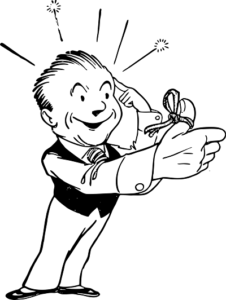- MN ABE Connect
- Archive
- How Memory Works
 December 14, 2020
December 14, 2020
How Memory Works
Wendy Sweeney, PANDA ManagerDecember is a month for making memories!
Many disabilities can impact memory, such as brain injury, ADHD, dyslexia, or mental health challenges. However, many ABE students struggle with retention for a variety of reasons. Learn how memory works and how to help your students retain information.
Making a memory: how does it work?
 How does our brain make memories? One way that the brain retains memories is by photographic images. Researchers often study “flashbulb memories”. A flashbulb memory is a detailed and vivid memory that is stored and retained for a lifetime. Usually, such memories are associated with important, memorable or traumatic events.
How does our brain make memories? One way that the brain retains memories is by photographic images. Researchers often study “flashbulb memories”. A flashbulb memory is a detailed and vivid memory that is stored and retained for a lifetime. Usually, such memories are associated with important, memorable or traumatic events.
What is Memory? Memory is the ability to store, retain, and subsequently recall information.
Memory can be broken down into three processes:
- Short-Term Memory is the immediate, very brief – lasts a couple seconds – automatic perception of information. This information is obtained through our senses – vision, hearing, smell, taste, and touch.
- Working Memory is the bridge from short term memory to long term memory. Working memory works to process and manipulate information into long term memory. However, it has a limited capacity – in general it can retain five to nine pieces of information at a time.
- Long Term Memory stores information that the brain retains because it is important to you – lasts a lifetime. For instance, childhood memories, home address, and family members.
ABE Case Study: Memory
Joe has been taking classes in ABE for the last three years. He does not seem to remember what he learns from day to day. He works slowly, needs information repeated and has difficulty following directions. He has become increasingly frustrated.
This story illustrates very common struggles for ABE students. You can help your student by teaching some of the following memory enhancement strategies.
Strategies to Improve Memory
Mnemonics is a method for enhancing memory. It is based on the idea that it is easier to remember surprising, humorous, or personal information. Often, the sillier the memory strategy is, the easier it is to recall. In addition to repeatedly practicing and rehearsing newly learned information, the following methods will improve memorization:
- Make a silly sentence out of the first letter of each item to be remembered or form words from the first letters.
The planets, in order of their distance from the sun are:
Mercury, Venus, Earth, Mars, Jupiter, Saturn, Uranus, Neptune, (Pluto)
A phrase commonly used to remember the order of the planets is:
My Very Earnest Mother Just Served Us Nine Pickles.
To remember the Great Lakes from west to east, use the acronym HOMES.
Huron, Ontario, Michigan, Erie, Superior.
- Rhymes, rhythm, songs or jingles can make things easier to remember.
A way to remember the grammar rule for which order “i” and “e” fall in words is:
“i before e except after c”.
To recall the year Columbus sailed for America, “In fourteen hundred and ninety-two Columbus sailed the Ocean Blue”. Or to recall which direction to tighten or loosen a screw or faucet remember this phrase, “Righty tighty; lefty loosey”.
- Chunking
Reducing the number of items to remember is valuable when trying to remember a lot of information. First determine what information is necessary to memorize, then reduce the number of items for students by grouping, or chunking, the information. Most people can only recall about 3-5 pieces of information at one time. That is why phone numbers and social security numbers are separated into chunks like 999-786-6425.
Look at the following chunks of letters: T WAN BAC BSC PRC IA. At first glance,
they look difficult to memorize. However, with simple chunking, look at them now:
TWA NBA CBS CPR CIA. You can chunk historical information by time periods or
events and chunk vocabulary words by grouping them into parts of speech.
Other types of memory strategies:
 Using multiple methods of instruction and multiple senses accesses different parts of the brain which improves retention and appeals to different learning styles.
Using multiple methods of instruction and multiple senses accesses different parts of the brain which improves retention and appeals to different learning styles.
- Use graphic organizers to help students learn to organize information while interacting and using a visual aid.
- Show students pictures or watch YouTube videos of topics to assist memory.
- Connect information to what the student already knows or has an interest in. This helps connect the new information to something already in long term memory.
- Ask a student to explain what they learned to you or another student. By explaining information to someone else it helps with understanding and recall.
- Use hands-on materials as much as possible. Experiencing information by touching and interacting with it assists memory better than just listening.
- Review what was learned from the last class before teaching new information and limit the amount of new information to no more than two things.
- Make information memorable and repeat it often. Repetition helps put information into long term memory. Use the 3 Rs: Read, Review, Repeat.
- Write it down. There is a direct connection between our brain and our hand. Interaction improves memory.
- Use multisensory instruction to access all of the brain’s pathways. Get more information on this printable What is Multisensory Instruction? handout.
For more memory tips, check out the following websites: http://www.ldonline.org/article/5894/ and https://add.org/top-10-memory-strategies/ Email [email protected] to request additional memory and multisensory instruction ideas.
Season’s greetings from Wendy Sweeney and Lori Yurick at PANDA!
Stay healthy and well.
Newsletter Signup
Get MN ABE Connect—the official source for ABE events, activities, and resources!
Sign UpArticle Categories
- ABE Foundations/Staff Onboarding
- ACES/Transitions
- Adult Career Pathways
- Assessment
- CCR Standards
- Citizenship
- COVID-19
- Cultural Competency
- Digital Literacy/Northstar
- Disabilities
- Distance Learning/Education
- ELA
- Equity/Inclusion
- ESL
- HSE/Adult Diploma
- Listening
- Math/Numeracy
- Mental Health
- Minnesota ABE
- One-Room Schoolhouse/Multilevel
- Professional Development
- Program Management
- Reading
- Remote Instruction
- Science
- Social Studies
- Speaking/Conversation
- Support Services
- Teaching Strategies
- Technology
- Uncategorized
- Volunteers/Tutors
- Writing